Top 8 Misconceptions about Cortical Visual Impairment (CVI)
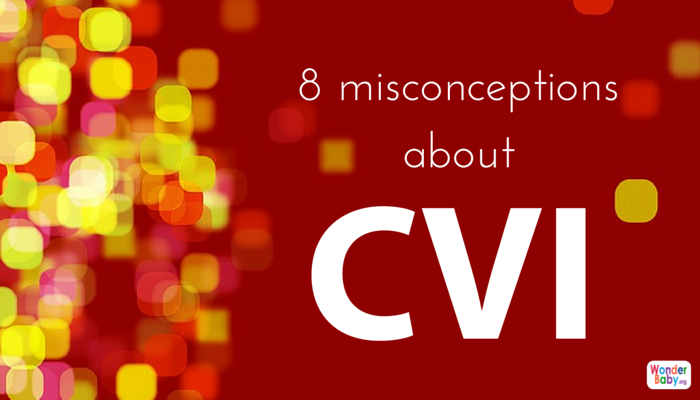
This post may contain affiliate links; please see our terms of use for details.
Have you ever been given wrong information about your child’s vision diagnosis or perhaps steered in the opposite direction of how to help your child reach his full potential? For your child, this can be devastating to his future, and for you as a parent, it will undoubtedly leave you angry, confused and on a mission to figure out what’s now best for your child. Unfortunately, this is too often the case for families of children with Cortical Visual Impairment (CVI), also referred to as Cerebral Visual Impairment or Neurological Visual Impairment.
Cortical Visual Impairment is a visual impairment caused by the brain’s inability to correctly process what is in front of the eye rather than a physical difference of the eye as in other visual impairments. For this reason, ophthalmologists often overlook the possibility of a CVI diagnosis and it is either misdiagnosed or goes completely undiagnosed until later in childhood.
New research in neurology and among teachers of the visually impaired, most notably Dr. Christine Roman, shows that some theories about Cortical Visual Impairment are not true. Developments in the understanding of brain plasticity, the ability of the brain to change throughout life, is undeniably an exciting factor in how children with CVI are taught. Since there are still many misconceptions about CVI, we’ve found the most common myths and their truths to hopefully clarify how a child with a CVI diagnosis actually sees.
Here are the top 8 misconceptions about Cortical Visual Impairment (CVI).
1. Black and white color combination is always best. FALSE!
Truth: Actually, highly saturated contrasting colors often make the best colors to attract your child’s attention.
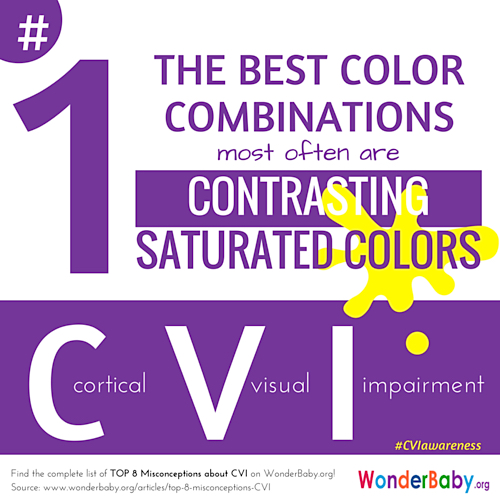
Try experimenting with bright, bold colors such as yellow, red, purple and orange to find out which ones your child responds to in his own way. Of course sometimes text is limited to black and white, and yellow if you’re lucky, so if possible, check to find out if a black background with white or yellow text is preferred by your child. For many kids with CVI, black and yellow work better than black and white.
A fun way to experiment with color combinations is using iPad apps that can be customized! Here are a few your child may enjoy:
- Bloom – Create pools of soft color accompanied by gentle sounding tones with the tap of your finger. It then echoes the sequence of sounds and colors for a fun and relaxing time. The color palette can be altered to be predominantly reds, yellows and oranges for children with CVI.
- EDA Play – This app lets you customize the level of play for your child’s Visual Level and Task Level ranging from simple fine motor and visual skills to more complex while tracking progress over time. The bright simple pictures are shown against a black background for kids with CVI.
Source: Little Bear Sees
2. Your child’s vision is constantly changing. FALSE!
Truth: It’s most likely environmental factors that have changed rather than your child’s vision.
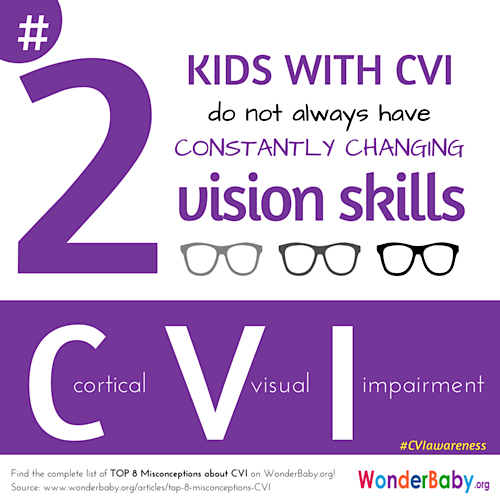
Are there external visual or auditory stimuli distracting your child’s attention? Is your child in an uncomfortable position or is the object in a different area of the visual field, i.e. center vs peripheral? All of the characteristics of CVI should be considered before assuming that your child’s vision is truly changing. Also, the possibility of fatigue or other feelings such as hunger or illness are causes that must be taken into consideration, too. In short, don’t just assume that your child’s vision is constantly changing anytime.
Ellen Cadigan Mazel, M.Ed. CTVI, Cortical Visual Impairment Advisor, shares on her CVI Teacher Blog, “It is my experience that stopping and evaluating the environment, identifying sensory complexity, and reducing it will improve a child’s abilities to use their vision.”
Sources: Little Bear Sees and CVI Teacher
3. Children with CVI must learn to use eye contact. FALSE!
Truth: Children diagnosed with CVI rarely use eye contact because of the complexity of the skills needed to do so.
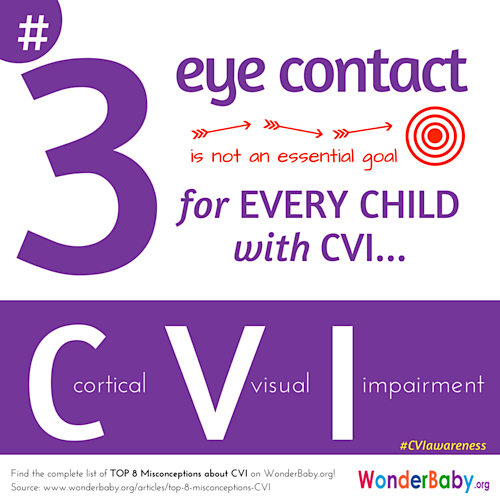
Consider just a few of the major characteristics of CVI such as visual latency, visual complexity, preference for movement, and distance impairment, and their direct involvement with human interaction. The definition of visual latency is in fact the delayed response when looking at objects where your child will look at an object and then look away. Also, it is seldom in every day occurrences that your child and another person will be in an environment without any other visual or auditory distractions that your child would prefer. The speaker will often move their hands and arms while talking, drawing your child’s visual attention to those areas rather than the speaker’s eyes.
In her TVI Teacher blog, Ellen Mazel, suggests focusing on other more attainable and important goals for your child instead of eye contact that will support eye contact once “visual skills are solid for less complex targets.”
Source: CVI Teacher
4. CVI is not a true visual impairment. FALSE!
Truth: CVI, also known as cerebral visual impairment, is a visual impairment.
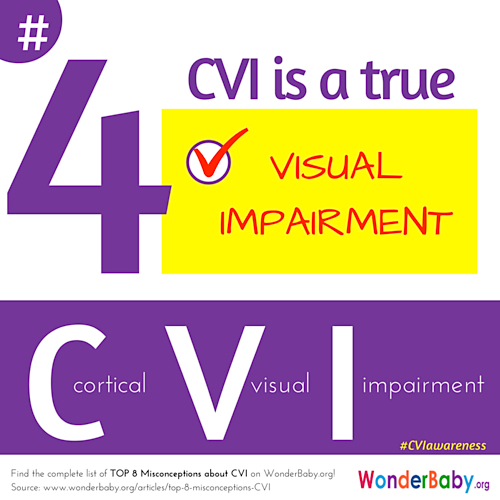
We may think of vision as only including our eyes. However, the sense of sight is more than the actual physical structure of the eyes. The eyes are connected to the brain to send message about what is in front of the eyes. Then, parts of the brain process the information to understand what the person is seeing. This entire system is technically what makes up our sense of sight. Therefore, if one or more of these steps is not functioning properly, whether it’s a physical or neurological problem, then the person is said to have a visual impairment.
Source: Neuroscience Online by UTHealth Medical School
5. All children with CVI have cognitive deficits. FALSE!
Truth: Each child with CVI will have different cognitive abilities from any another.
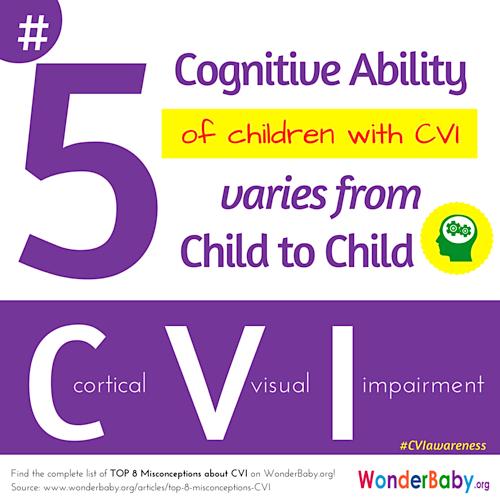
Cortical Visual Impairment can be the result of a variety of different medical causes including hypoxic ischemic encephalopathy (HIE) in full-term babies, periventricular leukomalacia (PVL) in premies, traumatic brain injury, epilepsy and other causes. The severity of the brain injury, the combination of CVI with other neurological or sensory impairments, and the degree of early intervention can also effect a child’s cognition level.
It is evident how important early intervention and consultations with doctors, educators and therapists highly experienced in working with children with CVI are to your child’s progress in resolving many of the associated challenges. If you have or are suspecting a diagnosis of CVI, talk to your child’s pediatrician for help in referring you to qualified resources. If you’re having trouble with connecting to qualified organizations, check out the American Association for Pediatric Ophthalmology and Strabismus (AAPOS).
Source: Boston Children’s Hospital
6. It’s OK to skip the CVI Range Assessment. FALSE!
Truth: The CVI Range Assessment developed by Dr. Christine Roman is a preferred assessment for the visual skills in children with CVI.
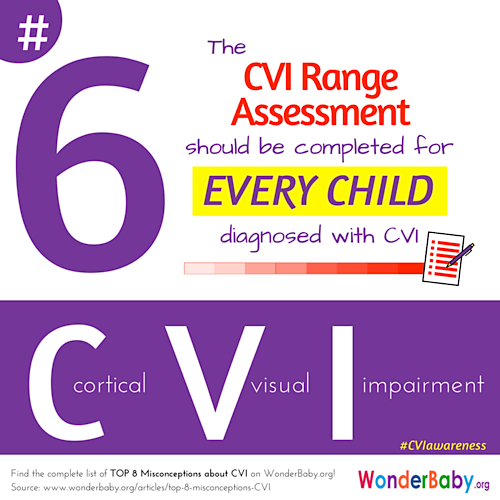
The traditional Functional Vision Assessment for ocular visual impairments does not give accurate information about a person diagnosed with CVI. In the beginning stages of a diagnosis, some ophthalmologists will overlook the possibility of CVI since it is not shown as a physical difference in the eye so it is important to gather input from your child’s teacher of the visually impaired and vision specialist. Parents are often the first to notice the signs of Cortical Visual Impairment such as inconsistent vision, long-term gazing, and preferences for familiar objects. The CVI Range Assessment using the Lantzy Scale should always be performed by a person trained to conduct the assessment for a child diagnosed with CVI. Doing so will help to properly determine the needs for educational goals, environment adaptations and other strategies for progressing through the Three Phases of CVI.
You can learn more about the CVI Range Assessment in Dr. Roman’s book, Cortical Visual Impairment from AFB Press.
Sources: Perkins eLearning and Cortical Visual Impairment by Christine Roman-Lantzy, AFB Press
7. Any motion or movement is bad. FALSE!
Truth: Quite the opposite! Movement is great for attracting the visual attention of a child with CVI.
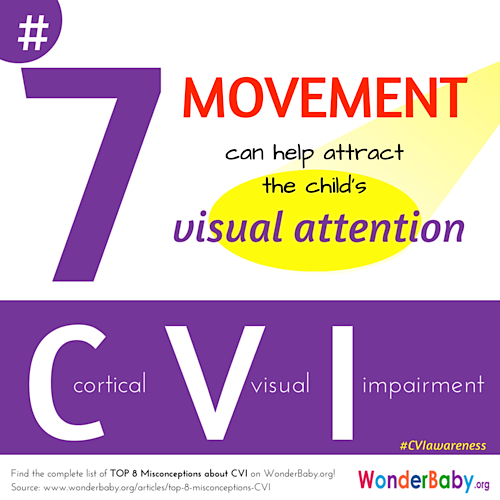
Children with CVI may look, then look away, but adding motion can often significantly increase their gazing time upon an object. Twinkling or shining of lights or metallic objects will give the appearance of movement even if the object is not physically moving. Try shining a light on the object or area you want the child to look at or shiny mylar balloons to attract your child’s attention. iPad apps designed specifically for children with CVI often incorporate movement and flashes in different parts of the screen to help kids learn.
Tap-N-See Now – Use this simple app to help your child learn to track moving objects or recognize colors; use their vision in a simple and non-cluttered environment; or learn about cause and effect—tapping the animal gets you a sound!
Sources: Perkins eLearning and Little Bear Sees Apps
8. Children with CVI are blind. FALSE!
Truth: Due to a number of characteristics exhibited by a child with CVI, it may seem as though he simply cannot see.
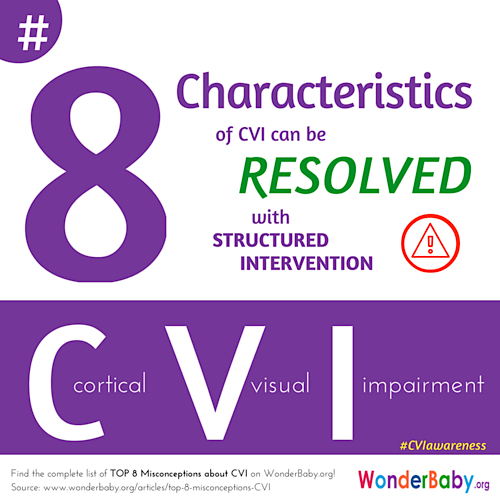
However, there is more to it… As explained more thoroughly in Myth #4 (CVI is not a true visual impairment), the child’s eyes are not physically affected, but rather the brain has problems decoding the information the eyes are sending. The fact that most children with CVI have some vision is better understood once you interpret the CVI characteristics and how to work with your child appropriately. Current findings show that children with CVI usually have some level of vision that may show some improvement over time. (Statistics have shown that some kids do have an ‘ocular visual loss’ diagnosis on top of a CVI diagnosis.)
The following characteristics of CVI could be misread as blindness:
- Visual Latency
- Visual Complexity
- Visual Field Preferences
- Distance Vision Impaired
- Absent Visual Blink Reflex
These findings make it obvious how important it is to have a doctor experienced with CVI to properly diagnose a child, as well as a ‘CVI-knowledgeable’ teacher to then create the best educational plan for a child diagnosed with CVI. The CVI Range Assessment and guiding principals for CVI characteristics are for determining proper strategies for working with a child with CVI. The progress of students using these specialized resources is profound and very encouraging!
Sources: Frontiers and Cortical Visual Impairment: An Approach to Assessment and Intervention by Christine Roman-Lantzy, AFB Press
Conclusion
Recent research has proven some theories wrong that doctors once thought were true about CVI. In order to make sure you have the most accurate information, be sure to check the date and source of any published information you come across. To keep updated on new findings, follow trusted researchers and doctors in the field such as Dr. Christine Roman. You can find more in-depth information by reading her latest book from AFB Press or take a short-course on CVI from Perkins eLearning.
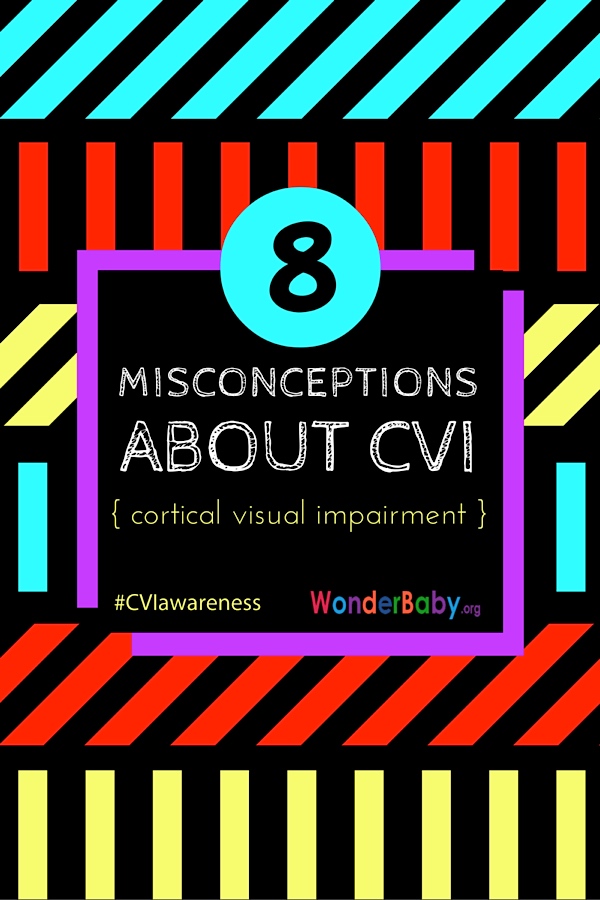
The information WonderBaby provides is not intended to be, and does not constitute, medical or other health advice or diagnosis and should not be used as such. Always consult with a qualified medical professional about your specific circumstances.
Related Posts

Eye Conditions and Syndromes, Visual Impairment
Neuralink Announces Plans to Restore Sight to the Blind with Brain Chip
Elon Musk’s company Neuralink has announced plans to begin human trials of its new “Blindsight” brain chip by the end of 2025.

Visual Impairment
The Gift of Understanding: How a Young Child Helps His Blind Father Navigate Life
When a parent is blind, it’s natural for people to wonder how their sighted child will adapt. Will they struggle to understand their parent’s needs? Will they feel burdened by...

Braille and Literacy, Toys, Visual Impairment
24 Braille Toys for Kids Who are Blind
Everything from alphabet blocks to raised line coloring pages and activity books to puzzles to card and board games... and so much more! And it's all in braille ready for...